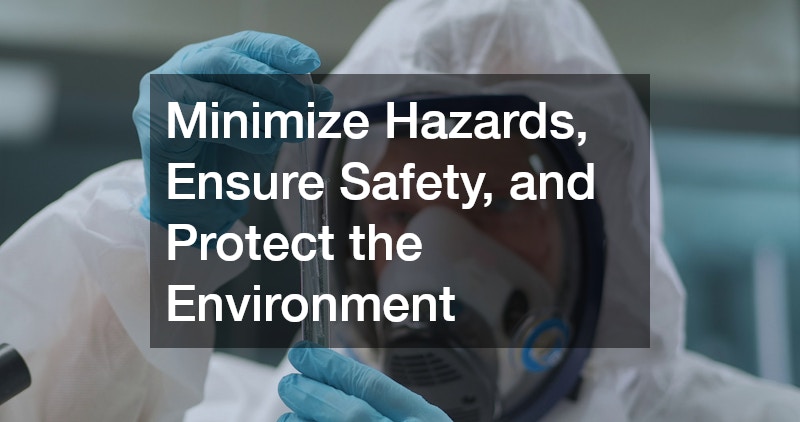In this article, we will explore the essential steps for the safe disposal of formalin, ensuring environmental safety and compliance with regulations. Proper disposal prevents hazards and protects both people and the environment.
1. Why is Safe Formalin Disposal Important?
Protecting Human Health and Safety
Improper handling of formalin can pose significant risks to human health, including skin irritation and respiratory issues. Long-term exposure can lead to more severe health effects, such as potential carcinogenic outcomes.
When formalin is mishandled, it can release harmful vapors that can affect individuals in the immediate vicinity. Ensuring proper disposal and handling minimizes these health risks and fosters a safer working environment.
By prioritizing safety standards, organizations can mitigate exposure risks and safeguard their employees’ well-being. Emphasizing health protection also boosts workplace efficiency and compliance with health guidelines.
Environmental Impact of Formalin
Improper disposal of formalin can lead to the contamination of water sources and soil. Such contamination can have severe consequences for aquatic ecosystems and can significantly impact biodiversity.
Water pollution from formalin can result in the disruption of marine habitats, affecting various species’ survival and reproduction rates. Likewise, soil contamination can result in long-term damage to the land’s fertility, affecting agricultural productivity.
Maintaining environmental balance is crucial, as ecosystems are interdependent. Protecting the environment from chemical hazards not only preserves nature but also fosters ecological sustainability.
2. What Are the Regulations Governing Formalin Disposal?
Understanding Local and Federal Regulations
Formalin disposal is governed by a complex framework of local and federal regulations designed to ensure safety and environmental protection. Compliance with these regulations is not optional but a mandated legal requirement for all relevant industries.
Organizations should be proactive in understanding the specific regulations that impact formalin disposal in their area. This involves staying aware of both existing laws and any upcoming changes or updates to disposal regulations.
Ensuring adherence to regulations demonstrates a commitment to safety and environmental stewardship. Proper regulatory compliance also reduces the risk of facing legal action or incurring penalties.
Penalties for Non-compliance
Failing to comply with formalin disposal regulations can result in significant legal and financial consequences. Penalties for non-compliance can include hefty fines and damage to an organization’s reputation.
Moreover, repeated violations can lead to more severe punitive actions, such as business shutdowns or criminal charges. The cost of non-compliance extends beyond financial aspects and can negatively impact a company’s long-term viability.
Therefore, companies must treat compliance as a priority, integrating it deeply into their operational strategies. By doing so, they can avoid unnecessary legal complications and foster positive community relations.
3. What are the Safe Methods for Formalin Disposal?
Neutralization and Dilution Techniques
Neutralization and dilution are key initial steps in the safe disposal of formalin. Neutralization involves converting formalin into non-toxic substances through chemical reactions, reducing its environmental impact.
Dilution, on the other hand, involves adding water to formalin to decrease its concentration before disposal. Both methods, however, must be carried out under strict safety protocols to ensure effectiveness.
Employing these techniques requires knowledge of proper procedures and an understanding of the chemistry involved. It is vital to train personnel thoroughly to execute these methods correctly and safely.
Commercial Disposal Services
Another viable option for safe formalin disposal is to engage commercial disposal services. These services are equipped with the expertise and facilities needed to handle hazardous chemicals safely.
Commercial disposal services ensure that formalin is processed and disposed of in compliance with local regulations. This not only alleviates the burden of disposal from organizations but also guarantees professional handling.
Such services are reliable partners in maintaining legal compliance and environmental protection. Partnering with certified services allows organizations to focus more on their core operations while ensuring safety standards.
4. How to Plan and Implement a Formalin Disposal Program?
Step-by-Step Planning Guide
Planning an efficient formalin disposal program requires a systematic approach tailored to specific needs. Start by assessing the volume of formalin waste to understand disposal requirements accurately.
Next, develop a detailed disposal plan, incorporating methods such as neutralization, dilution, or commercial disposal services. Creating a comprehensive plan ensures that every aspect of disposal is covered, reducing the risk of oversight.
Regularly review and update the disposal plan as regulations and organizational needs evolve. Maintaining an adaptable program enhances compliance and mitigates potential risks associated with formalin disposal.
Employee Training and Awareness
Proper training for employees handling formalin is crucial for effective disposal and safety. Comprehensive training programs should cover disposal techniques, safety protocols, and regulatory requirements.
Employee awareness is equally essential, as it promotes a culture of safety and compliance within the organization. Regular workshops and refreshers help in keeping the team updated on best practices and regulatory changes.
Investing in training not only equips employees with the necessary skills but also fosters confidence in handling hazardous materials. Such initiatives can significantly reduce risks and enhance safety standards across the board.
Safe formalin disposal involves understanding its risks, adhering to legal requirements, and applying appropriate methods. By following the key steps outlined above, we can minimize hazards, ensure safety, and protect the environment.



